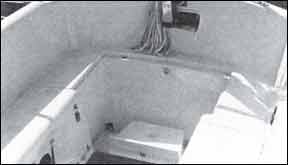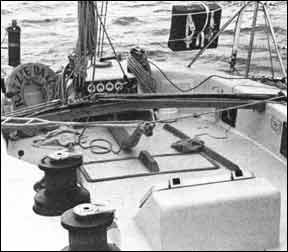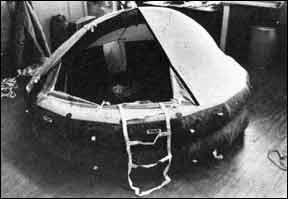Sometimes, it seems that safety is a dirty word in the boat- building industry. A favorite marketing catchword is “bluewater cruiser.” We assume this means a boat capable of going to sea, rather than a boat designed to tiptoe along the shore.
But when you go aboard the “bluewater cruiser”, more often than not you find a boat most suited for blue water when it is secured to the deck of a ship enroute to the dealer.
288
Nowhere is this more apparent than in the provisions made for the stowage of life rafts. Or rather, the lack of provision made.
Few people would venture offshore without a life raft, yet the location of the raft aboard the boat is almost always an afterthought. (“Well, now that we’re ready to go, where do we put the life raft?) More often than not, the raft gets tied down to the cabin top, lashed to the handrails. Every time the mainsail is reefed or furled, the raft gets walked on. Your guests sit on it while sunbathing. It is subject to vandalism or theft.
This is a poor way to treat an expensive piece of equipment, particularly one whose sole function is to keep you alive if your boat sinks And because it is very difficult to judge the condition of the raft from looking at the outside of the cannister or valise, you never can be sure that it hasn’t been damaged by careless handling.
If you are shopping for a boat for bluewater cruising, put life raft stowage near the top on your list of things to look for. Many European boats have life raft stowage built in. For example, the aft end of the cockpit of the Nicholson 31, an English boat that is perhaps the best serious small cruiser built anywhere, is designed to hold a valise life raft in completely protected yet readily accessible storage.
An alternative to designed-in storage is to modify an existing cockpit locker to serve as life raft stowage. The problem is that few cockpit lockers have lid dimensions that allow easy removal of a raft, and easy removal is an absolute necessity in an emergency. It is not reasonable to jam a life raft into a locker that must be shared with sails, anchors, fenders, or docklines. If you have a large cockpit locker that can be partitioned, so that the raft can be isolated from other items of gear, fine. But the raft must have priority when it comes to getting things out of the locker. You shouldn’t have to pull out the spare sails first.
288
Best: A Life Raft Locker
There is a little doubt that the safest way to store a raft is in a self-contained locker. “Safest” means many things. First, the raft is less likely to suffer damage from water, from being sat on or walked on, or from vandals. The raft is less likely to be stolen if it is kept in a locker that can be secured in port.
Perhaps most importantly, a raft stored in a properly designed locker is less likely to be washed overboard in heavy weather. It is difficult to imagine the force of a breaking wave, which can smash in ports or the side of a cabin, If a wave can do that, it can easily carry away a life raft lashed down to handrails atop the cabin.
Another disadvantage of stowing a raft atop the cabin is that the weight of the raft — about 90 pounds for a six- man, valise-packed raft — tends to raise the vertical center of gravity of the boat. While this may not be a problem aboard a 45-footer, it can be significant aboard a 30-footer.
If the raft is to be stored in a locker on deck, be sure that the latching system for the locker is strong enough to take the weight of the raft thrown against it in a knockdown. The raft’s painter should be secured to a padeye inside the locker that doesn’t interfere with removing the raft, or to another strong point outside the locker to which the painter can be led with the locker securely fastened. The latching system should also have provision to install a padlock.
Since the packed dimensions of life rafts vary greatly, there is no guarantee that a specific type of raft will fit in the raft stowage compartment of a given boat. A typical six-person valise-packed raft with a canopy occupies 2 1/ 2 to 3 cubic feet, but the distribution of that volume can be quite different between brands. Most valise rafts bear a close resemblance to a large seabag, but both diameter and length can vary. If you’re shopping for a boat, carry the dimensions of the life rafts you’re considering around with you to compare with the lockers aboard boats.
288
It would be sheer folly to equip a boat with an aircraft-type life raft-a single bouyancy tube -just because there’s no locker aboard big enough for a marine life raft.
Below Decks: Not as Good
The Special Regulations of the Offshore Racing Council, the Bible of boat preparation for offshore racing, allow life rafts weighing less than 88 pounds to be carried belowdecks if they are kept in close proximity to the companionway. This is about the size of a six-man valise raft.
In theory, a raft stowed below will not be damaged or carried away by a boarding sea. In practice, stowing a raft below carries risks. In the first place, few boats have a place near the companionway that a bulky raft can be stowed without interfering with the flow of traffic. In addition, hoisting a heavy raft out the companionway is a big job for one person with the boat tied at the dock, much less if the boat is sinking in a heavy gale. A large raft will just barely fit through a companionway which is small enough to be safe for offshore sailing.
The Cockpit Well? The Deck?
It is sometimes possible to create reasonably good raft stowage in the cockpit well. If the cockpit well is narrow, wooden cleats can be screwed to the sides of the well, and a plywood cover fitted to them, in effect turning the well into a box. Ideally, the raft would not sit directly on the cockpit sole, where it might sit in water, but would be raised up slightly by a grate.
The trick with this installation is to make the wooden cover secure enough to stay in place during a knockdown, but easily removable in an emergency. In addition, of course, a large chunk of the cockpit is wiped out as sitting space. This is less of a drawback than it may seem. Aboard the racing boat, the crew rarely, if ever, sits in the cockpit. Aboard the shorthanded offshore cruiser, the helmsman may be the only person on deck.
A valise raft should not be stowed on the cockpit sole without the protection of some sort of rigid cover. Sooner or later, someone’s bound to walk on it, and the risk of damage is simply too great.
288
If the life raft must be stowed in an exposed location, it must be of the cannister (rigid container) type. Cannisters are either molded fiberglass or ABS plastic, and they as a rule offer much better protection to the raft than a fabric valise. They are not, however, proof against damage. Cannisters are resistant to spray, but they are not immune to immersion.
For this reason, mounting a cannister raft on the foredeck of a boat is a poor practice. To some extent, mounting on the stern carries the same risk, but a boat is much more likely to carry solid water on the foredeck than on the stern in heavy weather. Mounting the raft aft also has the advantage that it is closer at hand to the helmsman. Carrying a cannister raft atop the cabin has the same effect on the vertical center of gravity as carrying a valise in that position, but the cannister can be mounted without relying on handrails.
Most life raft manufacturers make metal or molded fiberglass mounts for cannister rafts. When using this type of mount, it is imperative that heavy bolts, nuts, and backup plates be used in the installation, just as if you were mounting a heavily loaded piece of deck hardware.
It does no good to mount the bracket strongly to the boat if the cannister is held in the bracket by a piece of light line secured to a flimsy padeye. Remember that the system is only as strong as the weakest link. If the raft is secured with strong webbing without a quick release system, a sheath knife can be taped to the cannister for use in an emergency. The knife must be sharpened regularly, and checked frequently to make sure it is still in place.
If the cockpit well is wide enough, it may be possible to mount a cannister raft to the cockpit sole. Once again, the footwell is sacrificed. As a rule, a cylindrical cannister is more likely to fit in a cockpit well than a flat cannister. A flat cannister, with its lower windage, is a much better choice for mounting at deck level or atop the deckhouse.
A cannister mounted in the cockpit well may be more rugged than a valise, but it still should not be walked on.
288
Some very large cockpits may actually benefit from mounting a raft there. The volume of water the cockpit would hold in the event of flooding is reduced. In addition, in a boat with no bridgedeck, a box to contain the raft could be built at the forward end of the cockpit, reducing the size of the companionway opening, in effect creating a bridgedeck. While the installation would have to be engineered for each boat, construction should be within the reach of a reasonably handy man or woman.
No matter where the raft is mounted on deck, a strong point must be provided for the attachement of the raft’s painter, which not only serves to keep the raft connected to the boat, but also activates the raft’s inflation mechanism. It does no good to launch the raft over the side and watch it drift away because the painter was not tied down, or was tied to a weak point which tore out. It is best not to secure the painter to a cleat. It may be untied while handling sheets or docklines, and it’s easy to forget to hook things back up.
Conclusions
The provisions for life rafts, like the stowage of the rest of the boat’s safety equipment, should be near the top of the list, no matter what type of sailing a boat is to do.
The raft must be protected from the elements, protected from theft, yet easily deployed in an emergency.
There’s a good chance -an overwhelming likelihood, in fact -that the boat that you own, or are considering buying, has no good location for stowing a raft.
If you plan on sailing offshore, you should give at least as much thought to what you’re going to do with the life raft as you give to plans for the dishes in the galley and the toilet paper in the head. And that’s no joke.







































